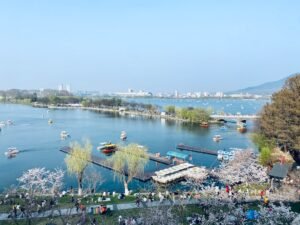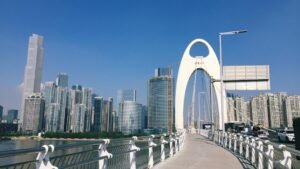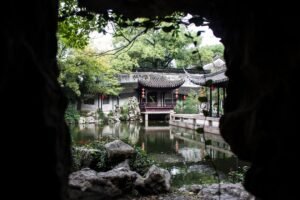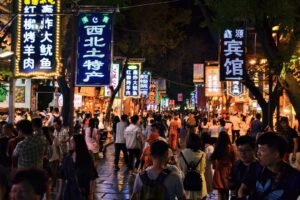

Navigating a City: How to Ask for Directions in Mandarin Chinese
Navigating a city can be a daunting task, especially when the language spoken is not your own. For those venturing into Mandarin-speaking regions, the ability to communicate effectively can significantly enhance the experience. Mandarin Chinese, with its unique tonal qualities and intricate characters, presents both challenges and opportunities for learners.
Understanding how to ask for directions, interpret responses, and engage with locals can transform a potentially overwhelming experience into an enjoyable adventure. This article aims to equip you with essential phrases and cultural insights that will facilitate your journey through a Mandarin-speaking city. As you prepare to explore the vibrant streets of cities like Beijing or Shanghai, it is crucial to familiarise yourself with the basic linguistic tools that will aid in navigation.
The ability to ask for directions not only helps you reach your destination but also opens doors to interactions with local residents. By learning key phrases and understanding the cultural nuances of communication in Mandarin, you will find yourself more confident and capable of immersing in the local environment. Start learning Chinese at the NLS Norwegian Language School in Oslo now!
Table of Contents
ToggleSummary
- Navigating a city in Mandarin Chinese can be made easier by learning basic phrases for asking for directions and understanding polite language and cultural considerations.
- Using landmarks and street names can help in getting around a city and understanding responses and follow-up questions is important for effective communication.
- Public transportation and directions are essential for getting around a city and knowing how to seek help in emergency situations is crucial.
- Navigating tourist attractions and popular destinations can be made easier by learning additional resources for learning Mandarin Chinese and improving pronunciation and fluency.
- In conclusion, learning Mandarin Chinese for navigating a city is important and can be made easier by following these key points.
Basic Phrases for Asking for Directions
When it comes to asking for directions in Mandarin, a few essential phrases can make all the difference. The most fundamental phrase is “请问” (qǐng wèn), which translates to “Excuse me” or “May I ask.” This polite introduction sets a respectful tone for your inquiry. Following this, you can ask “……在哪里?” (……zài nǎ lǐ?), meaning “Where is…?” For example, if you are looking for a train station, you would say “火车站在哪里?” (huǒchē zhàn zài nǎ lǐ?).
In addition to these phrases, it is helpful to know how to express gratitude after receiving assistance. A simple “谢谢” (xièxiè), meaning “Thank you,” goes a long way in showing appreciation for the help you receive. Practising these phrases will not only aid in navigation but also foster goodwill among locals, who often appreciate the effort made by non-native speakers to communicate in their language.
Polite Language and Cultural Considerations

Politeness is a cornerstone of communication in Mandarin culture, and understanding this aspect can greatly enhance your interactions. In addition to using polite phrases like “请问” (qǐng wèn), it is important to maintain a respectful tone throughout your conversation. Using titles such as “先生” (xiānsheng) for Mr or “女士” (nǚshì) for Ms can add an extra layer of respect when addressing someone.
Moreover, non-verbal communication plays a significant role in Mandarin-speaking cultures. A friendly smile and maintaining eye contact can convey sincerity and openness. It is also customary to bow slightly when greeting someone or thanking them, as this gesture signifies respect.
Being aware of these cultural nuances will not only help you navigate the city more effectively but also create positive connections with the people you meet along the way.
Using Landmarks and Street Names
When navigating a city, landmarks serve as invaluable reference points. In Mandarin, landmarks are often referred to by their specific names, which can be quite different from their English counterparts. Familiarising yourself with key landmarks in the city you are visiting can aid in both asking for directions and understanding responses.
For instance, if you are trying to find the Forbidden City in Beijing, knowing its name in Mandarin—故宫 (gùgōng)—will be essential. Street names also play a crucial role in navigation. Many street names in Mandarin include directional indicators such as “东” (dōng) for east or “西” (xī) for west.
Understanding these terms will help you follow directions more accurately. For example, if someone tells you to go straight down “东直门” (Dōngzhímén), knowing that “东” indicates east will guide you effectively. By combining your knowledge of landmarks and street names, you will be better equipped to navigate the urban landscape.
Understanding Responses and Follow-up Questions
Once you have asked for directions, understanding the responses is equally important. Responses may vary from simple directional cues to more complex explanations involving multiple turns or landmarks. It is beneficial to learn some common phrases that may appear in responses, such as “左转” (zuǒ zhuǎn) meaning “turn left,” or “右转” (yòu zhuǎn) meaning “turn right.” Additionally, follow-up questions can clarify any uncertainties you may have about the directions given.
Phrases like “再说一遍” (zài shuō yī biàn), meaning “Can you say that again?” or “我不太明白” (wǒ bù tài míngbái), meaning “I don’t quite understand,” can be useful tools in ensuring that you grasp the information correctly. Engaging in this manner not only helps you navigate more effectively but also demonstrates your willingness to communicate and learn.
Using Public Transportation and Directions

Public transportation is often the most efficient way to navigate a city, and understanding how to use it in Mandarin is essential. Familiarising yourself with terms related to public transport can greatly enhance your experience. For instance, knowing that “地铁” (dìtiě) refers to the subway or metro system will help you when asking about train routes or schedules.
When seeking directions for public transport, phrases like “怎么去…” (zěnme qù…) meaning “How do I get to…” followed by your destination will be particularly useful. Additionally, understanding the names of different transport stations will aid in ensuring you board the correct vehicle. Many cities have apps available that provide information in both Mandarin and English, making it easier for non-native speakers to navigate public transport systems.
Emergency Situations and Seeking Help
In any city, emergencies can arise unexpectedly, making it crucial to know how to seek help effectively. In Mandarin, if you find yourself in need of urgent assistance, saying “救命!” (jiùmìng) translates to “Help!” This phrase can alert those nearby that you require immediate support. For less urgent situations where you may need assistance finding your way or dealing with an issue, phrases like “我迷路了” (wǒ mílù le), meaning “I am lost,” can be invaluable.
Additionally, knowing how to ask for help from authorities or police can provide peace of mind during your travels. The phrase “警察在哪里?” (jǐngchá zài nǎlǐ?), meaning “Where is the police?” can guide you towards safety if needed.
Navigating Tourist Attractions and Popular Destinations
Tourist attractions often come with their own set of challenges when it comes to navigation. Knowing how to ask about popular destinations can enhance your experience significantly. For instance, if you’re interested in visiting the Great Wall of China, asking “长城在哪里?” (Chángchéng zài nǎlǐ?) will direct locals to provide guidance on how best to reach this iconic site.
Additionally, many tourist attractions have specific entry points or ticketing areas that may not be immediately obvious. Familiarising yourself with common phrases related to tickets—such as “票在哪里买?” (piào zài nǎlǐ mǎi?), meaning “Where do I buy tickets?”—can streamline your visit and ensure that you make the most of your time at these popular sites.
Additional Resources for Learning Mandarin Chinese
To further enhance your ability to navigate a city in Mandarin Chinese, utilising additional resources can be incredibly beneficial. Language learning apps such as Duolingo or HelloChinese offer interactive lessons that focus on practical vocabulary and phrases relevant to everyday situations, including navigation. Moreover, engaging with native speakers through language exchange platforms can provide real-world practice that is invaluable for improving fluency and comprehension.
Joining local language groups or attending classes at institutions like the NLS Norwegian Language School in Oslo can also offer structured learning environments where you can develop your skills further.
Tips for Improving Pronunciation and Fluency
Improving pronunciation and fluency in Mandarin requires consistent practice and exposure to the language. Listening to native speakers through podcasts or watching Chinese films can help attune your ear to the tonal nature of Mandarin. Mimicking pronunciation and intonation patterns will aid in developing a more authentic speaking style.
Additionally, practising speaking with language partners or tutors can provide immediate feedback on your pronunciation and usage of phrases. Recording yourself speaking Mandarin and comparing it with native speakers can also highlight areas for improvement. The more you immerse yourself in the language through various mediums, the more confident you will become in navigating conversations while exploring a city.
Conclusion and Recap of Key Points
Navigating a city in Mandarin Chinese may seem challenging at first glance; however, with the right tools and knowledge, it becomes an enriching experience filled with opportunities for connection and discovery. By mastering basic phrases for asking directions, understanding cultural considerations, and familiarising yourself with landmarks and public transportation terminology, you will find yourself better equipped to explore urban landscapes confidently. Moreover, being prepared for emergency situations and knowing how to seek help are crucial aspects of ensuring a safe journey.
Engaging with additional resources such as language apps or classes at institutions like the NLS Norwegian Language School in Oslo can further enhance your learning experience. Ultimately, embracing the language not only aids navigation but also fosters deeper connections with the culture and people around you—transforming your travels into unforgettable adventures filled with meaningful interactions.
Register for a Chinese class at the NLS Norwegian Language School now!
If you want to learn Norwegian, you can register for classes here. We look forward to hearing from you and helping you become fluent in Norwegian.





